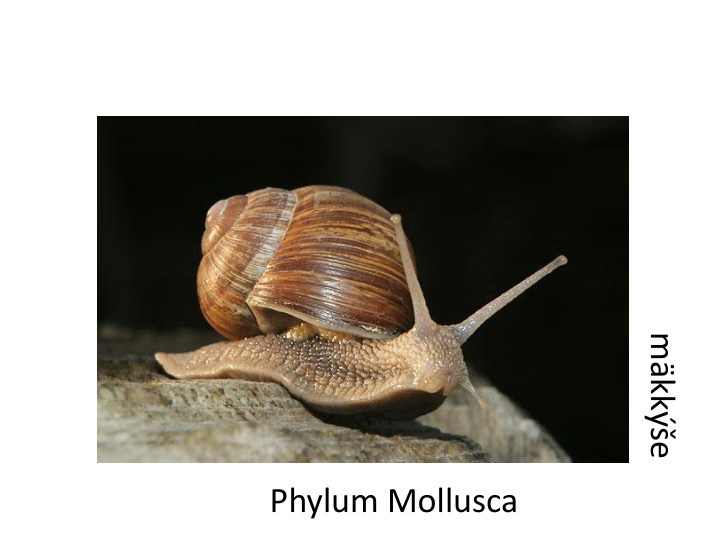



mäkkýše Phylum Mollusca
General characteristics - molluscus – soft (latin) - second largest animal phylum - includes chitons, snails, slugs, clams, oysters, squid, octopus & nautilus - bilaterally symmetrical - cephalization - have a distinct head with sense organs & brain - go through free-swimming larval stage called trochophore
General characteristics - all share similar development pattern and common body plan: - mantle – protective „ coat “ covering soft-bodies that may or may not form a hard, calcium carbonate shell - visceral mass - body organs below mantle - muscular foot for movement which is modified into tentacles for squid & octopus - gills between the mantle & visceral mass used for gas exchange
General characteristics - all share similar development pattern and common body plan: - mantle – protective „ coat “ covering soft-bodies that may or may not form a hard, calcium carbonate shell - visceral mass - body organs below mantle - muscular foot for movement which is modified into tentacles for squid & octopus - gills between the mantle & visceral mass used for gas exchange
General characteristics Includes 4 classes: Polyplacophora (chitons) Gastropoda (snails, slugs, nudibranchs, conchs) Bivalvia (clams, oysters & mussels) Cephalopoda (squid, octopus & nautilus)
Polyplacophora Chitons
Gastropoda (ulitníky) - 1 shell often coiled - distinct head with eyes and sense organs - radula slug - some terrestrial, aquatic snail
conch
Bivalvia (lastúrniky) oysters clams mussels
Bivalvia - 2 part shells - no head or eyes - filter-feeders - live in water (gills)
Cephalopoda (hlavonožce) squid octopus nautilus
Cephalopoda - well developed brain and eyes - fast moving predators - foot is modified to tentacles - camouflage or jet propulsion when threated
Structure of Mollusca
Structures and functions Digestive system - complete one-way digestive tract mouth → anus (mouth, oesophagus, stomach, intestine, anus) - radula - a scraping, tongue-like structure (gastropoda) beak (cephalopodes) Excretory system - nephridia – remove metabolic waste (amoniac) - digestive waste through anus
Structures and functions Respiratory system - aquatic mollusks have gills - terrestrail mollusks have primitive lungs (highly folded mantle) Circulatory system - open circulatory system (gastropodes, bivalvia) – heart pumps hemolymph (blood) through open space - close circulatory system (cephalopodes)
Structures and functions Nervous system - Bivalvia – reduced NS , no head - Gastropoda – fairy basic (nerve cord and ganglia) - Cephalopoda – very well developed - very good vision - ability to learn (memory)!!! Reproduction system - most gonochorists (separate sexes) - external or internal (terrestrial species) fertilisation
Ecology - used by humans for food - pearls from oysters - shells used for jewelry - do crop & garden damage - serve as intermediate hosts for some parasites such as flukes
Slizniak karpatský
Recommend
More recommend